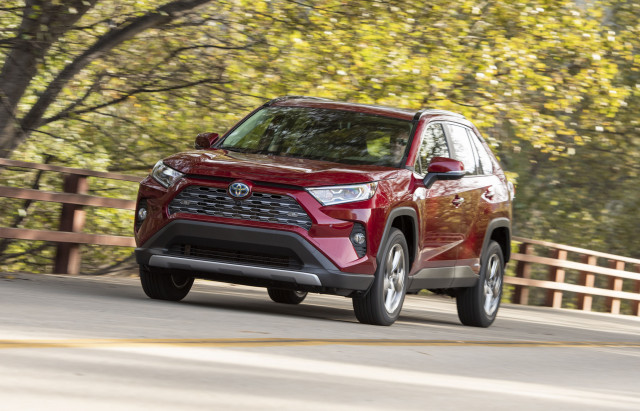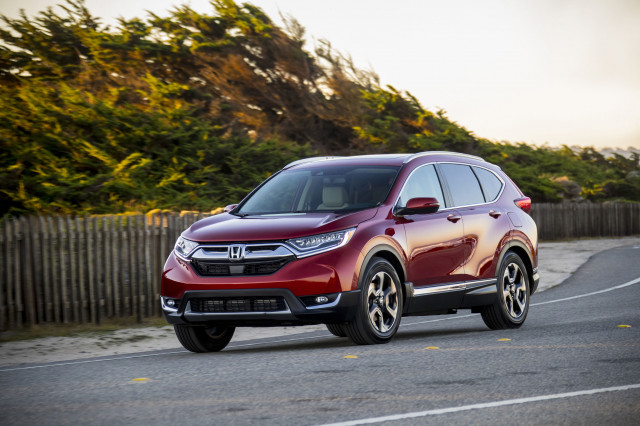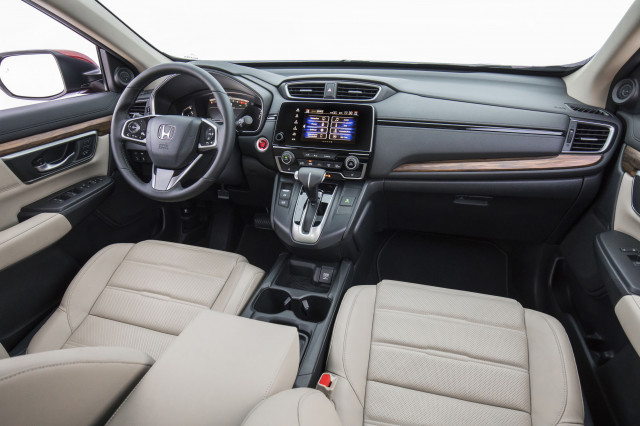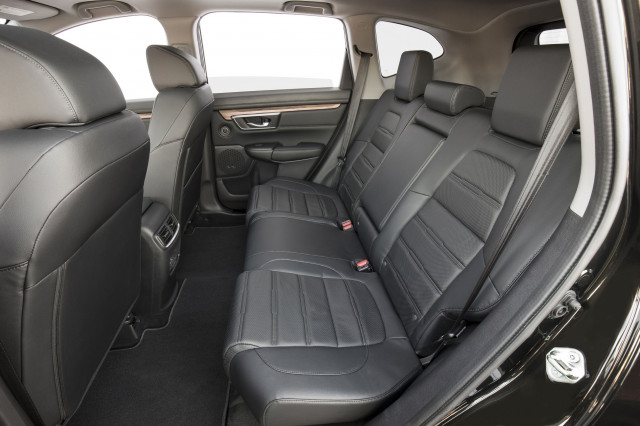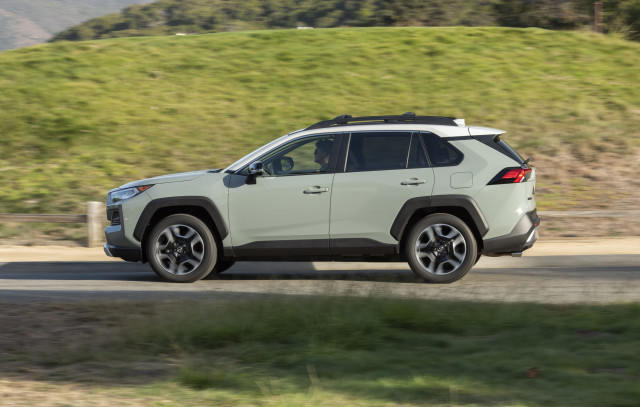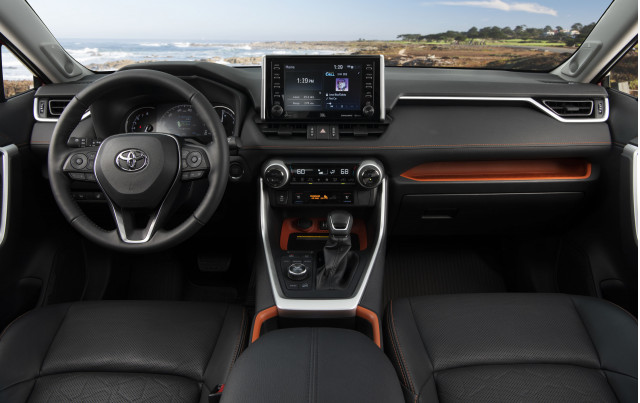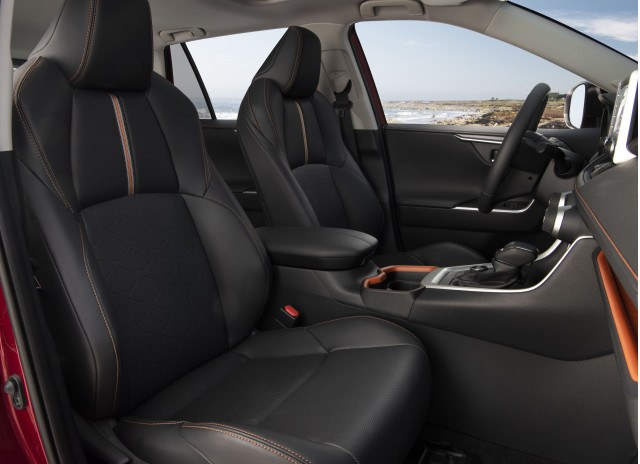2019 Toyota RAV4
It doesn’t have the ring of “Frazier-Ali”—or even Todd Bridges-Vanilla Ice—but the 2019 Toyota RAV4 and 2019 Honda CR-V are automotive heavyweights that square off daily on dealer lots.
They’re among the most popular crossover SUVs on sale today and it shows: the range and breadth of each lineup appeals to broad swathes of buyers.
On paper, it’s a tight race. The RAV4, which is newer, rates 6.2 and the CR-V rates 6.0.
On looks alone, we’d give it to the RAV4. On space and versatility, the CR-V gets the nod. Fuel economy? That EPA’s scorecard calls it a virtual draw.
Let’s rumble.
MORE: Read our 2019 Honda CR-V and 2019 Toyota RAV4 review
2019 Honda CR-V
2019 Honda CR-V
2019 Honda CR-V
The tale of the tape is tight. The RAV4 measures 105.9 inches between its wheels, the CR-V stretches just 104.7, but bumper-to-bumper they’re less than an inch apart (180.6 inches vs. 180.9 inches). Leg room in the CR-V is slightly more spacious, but the RAV4’s not bad either.
We’re more enamored with the metal that Toyota wraps around those dimensions. The RAV4, which was new for this year, is better looking than the now-frumpy CR-V. By our eyes, the CR-V prioritizes function over form in some unflattering ways—particularly at the rear. The RAV4, by contrast, is better looking with a mini-off-roader look that’s butch and refreshing. Among small crossovers, the new RAV4 rates close to the top for style.
There are some concessions for that flair however; the RAV4’s roofline is about an inch lower than last year and tall drivers may need to duck to get in. The Toyota’s rear doors also don’t open as wide as we’d like, so families with car seats should dry run before driving one home.
Both crossovers offer two powertrains with an efficiency push, albeit in different applications. The base engine for the CR-V LX is an uninspired 2.4-liter inline-4 that makes 184 horsepower. It gets the job done. The powertrain in CR-V EX and higher is a 1.5-liter turbo-4 that makes just 190 hp mated to a continuously variable automatic transmission (CVT), and it’s better suited for efficiency and quicker takeoffs. According to the EPA, the 1.5-liter turbo-4 returns up to 29 mpg combined with all-wheel drive.
The base Toyota RAV4 engine is a 203-hp, 2.5-liter inline-4 hooked to an 8-speed automatic that’s more willing than Honda’s base offering. The EPA says with all-wheel drive, the RAV4 rates up to 28 mpg combined.
One in four new RAV4s will be a hybrid that combines batteries and electric motors with the 2.5-liter inline-4 to make 219 hp. It uses a CVT for better efficiency too, although final EPA numbers aren’t yet available. Toyota estimates the RAV4 Hybrid will return up to 39 mpg combined.
We like the CR-V’s agile attitude and the RAV4’s power. Both steer easily, although the CR-V is calmer over rutted roads. We call it a wash.
Inside, the CR-V makes better use of its space with more stretch-out room for rear-seat riders and more cargo capacity: 37 cubic feet in the RAV4 vs. 39.2 cubes in the CR-V. (The RAV4’s cargo space grows slightly depending on moonroof configuration.)
2019 Toyota RAV4
2019 Toyota RAV4
2019 Toyota RAV4
Safety and features
Regardless of which model you choose, there’s good news: The Toyota RAV4 and Honda CR-V set the bar for available active safety features on most new cars. Both are equipped with their respective manufacturers’ latest and greatest active safety features.
The bad news: The base CR-V skips active safety equipment that the rest of the range gets. That’s a shame. CR-V EX models and higher are equipped with standard automatic emergency braking, adaptive cruise control, and active lane control. Crash testers gave the CR-V top marks including a Top Safety Pick nod by the IIHS and a five-star overall rating by federal testers.
The RAV4 hasn’t yet been crashed by federal or independent testers, but every trim level is equipped with automatic emergency braking, adaptive cruise control, and active lane control.
Honda doesn’t fit base CR-Vs with the good stuff. The 2019 CR-V LX skips active safety and smartphone compatibility on its 5.0-inch display with a low-power USB charger. The base CR-V LX with front-wheel drive costs $24,345.
The base Toyota RAV4 LE hits higher notes with active safety gear, a 7.0-inch touchscreen with Apple CarPlay compatibility, one USB power port, and a 4.2-inch display in its instrument cluster. The base RAV4 LE costs about $26,500, but offers more standard equipment than the CR-V.
In the end, it’s a slugfest but the RAV4 nudges ahead slightly with its updated looks, powertrain, and base safety equipment.
In nearly every trim, the RAV4 and CR-V duke it out for crossover supremacy but in the end, we just say buyers win.
Summary
Styling
Performance
Comfort & Quality
Safety
Features
Fuel Economy
MSRP
Invoice
Fuel Economy – Combined City and Highway
Engine
Drivetrain
Source: Read Full Article

